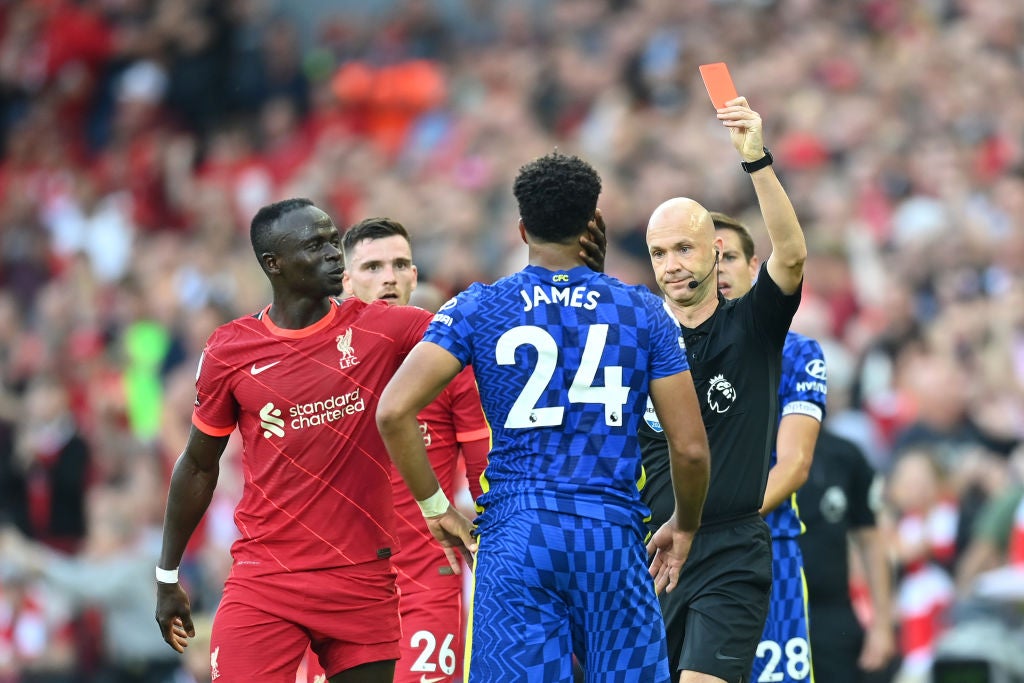Handball rule: After Reece James’ red card in Liverpool vs Chelsea is it time for the ‘penalty goal’?
It seems outdated and almost from a different era of football to both give a penalty and a red card for handball on the line

For all the questions this 1-1 draw between Liverpool and Chelsea left about these two title challengers, it maybe left a bigger one about the very laws of the game.
Is it time to introduce the “penalty goal” for unintentional handball on the line?
The problem with the current laws is that it is a double punishment. A player is sent off and a penalty is given, which seems extraordinarily harsh given that these handballs can sometimes come from innocuous movements.
Whether Reece James’ movement in Liverpool-Chelsea was innocuous, or unintentional, is of course up for debate. It did look more deliberate in slow motion, but that’s why slow motion isn’t always completely reliable in these circumstances. It changes perspective, and sometimes doesn’t reflect the reality of real-time.
It did seem like James was trying to adjust his body as the ball was smashed towards him at point-blank range and could do nothing to get out of the way even if he tried. Jurgen Klopp admitted it was "harsh".
Thomas Tuchel diplomatically stated it was not “super unnatural” body position, and was hugely frustrated with that decision, as well as the means with which Anthony Taylor came to it.
“The referee just saw one picture – a frame, he took the very quick decision. He didn't see the whole situation, the deflection, a very unintentional handball.”
The problem for Tuchel is that, right now, intent is irrelevant to the laws on this situation. They read that it is a red card “Where a player denies the opposing team a goal or an obvious goal-scoring opportunity by a handball offence the player is sent off wherever the offence occurs.”
The issue is the lack of nuance to that. The ball being on the line or heading towards goal in the six-yard box is so specific - and so quickly observable with VAR - that it seems outdated, and almost from a different era of football, to both give a penalty and a red card.
The rule was already changed five years ago for unintentional fouls that deny goalscoring opportunities. The thinking then was that it was a triple punishment, since it led to a red, a suspension and the penalty.
As such, the punishment was relaxed so accidental fouls would only be cautioned along with the penalty.
It feels like the same principle could be applied here, but a significant difference is the certainty of a goal if there isn't a handball.
It isn’t the same as a player bearing down or about to finish since they could easily miss. This is when the ball is clearly on the way over the line.
The simple awarding of a penalty goal seems a much fairer outcome. It ensures justice is done, but doesn’t distort the game.
Another clear example is the most infamous: Luis Suarez against Ghana in the 2010 World Cup.
The irony was that it didn’t even feel like justice since Ghana missed the penalty, and Uruguay eventually went through - on penalties - with 10 men.
A penalty goal would have been much straighter, more logical. It was that obvious.
Here, it was obvious the red card changed the pattern of the game. Both Tuchel and Klopp agreed it “spoiled” it, even as a neutral.
It may be worth a bit more debate over whether more nuance should be applied to the circumstances.
It may save games and ensure greater justice.
Subscribe to Independent Premium to bookmark this article
Want to bookmark your favourite articles and stories to read or reference later? Start your Independent Premium subscription today.

Join our commenting forum
Join thought-provoking conversations, follow other Independent readers and see their replies